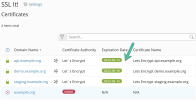- Server operating system version
- Ubuntu Linux 22.04.1 LTS
- Plesk version and microupdate number
- plesk obsidian 18.0.50u2 WebAdmin Edition
I have 2 domains configured on my Ubuntu server and in the web interface both of them show up as secured by let's encrypt certificates.
As it is very cumbersome to check the expiration dates from the web GUI, I used to use a script which extracts the expiration dates from the certs on the file system.
This worked well on my previous server with Ubuntu 20, but after migrating to an Ubuntu 22 server, I am missing a certificate file.
ls /opt/psa/var/modules/letsencrypt/etc/live/* only lists a general _plesk_domain and 1 of my domains.
My 2nd domain is missing, although the web interface shows the certificate for it.
Are the certificates stored somewhere else now?
As it is very cumbersome to check the expiration dates from the web GUI, I used to use a script which extracts the expiration dates from the certs on the file system.
This worked well on my previous server with Ubuntu 20, but after migrating to an Ubuntu 22 server, I am missing a certificate file.
ls /opt/psa/var/modules/letsencrypt/etc/live/* only lists a general _plesk_domain and 1 of my domains.
My 2nd domain is missing, although the web interface shows the certificate for it.
Are the certificates stored somewhere else now?
for Cert in $(ls /opt/psa/var/modules/letsencrypt/etc/live/*/cert.pem)
do
echo $Cert
cat $Cert | openssl x509 -dates -noout 2>&1 | sed -e 's/^notBe/ &/' -e 's/^notA/ &/'
done

